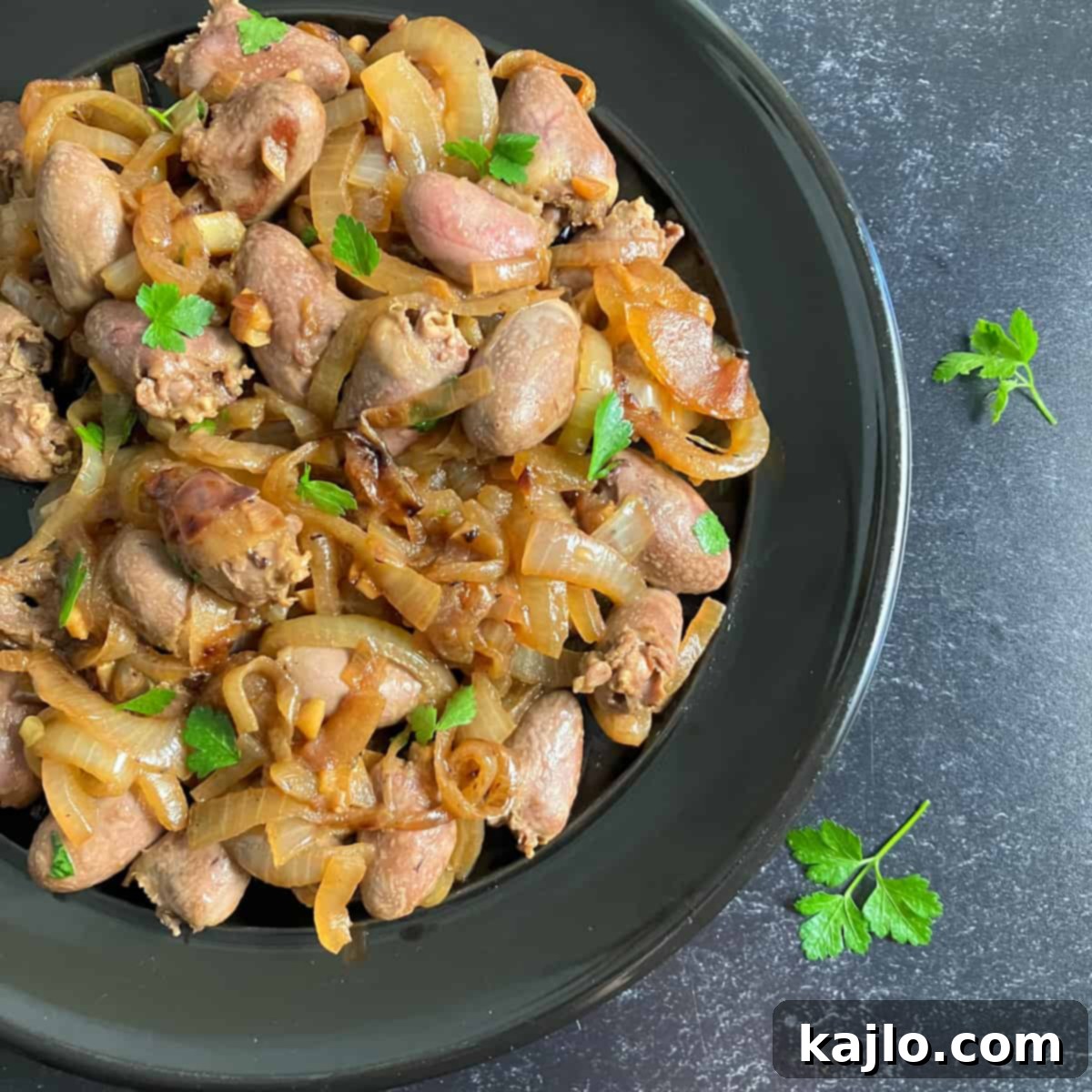Unlock the secret to delicious and nutritious cooking with this ultimate pan-fried chicken hearts recipe. Often overlooked, chicken hearts are a true culinary gem, offering a tender texture and rich flavor that beautifully complements savory onions and aromatic garlic. This easy-to-follow guide will show you exactly how to cook chicken hearts to succulent perfection, making them ideal for a hearty appetizer or a healthy main course. Beyond the plate, we’ll explore the remarkable nutritional benefits of this often-underestimated organ meat, delve into effective sourcing strategies, and provide expert tips for a seamless cooking experience. Discover an offal recipe that is naturally low-carb, keto-friendly, Paleo, and gluten-free, bringing unique flavors and vital nutrients to your table.
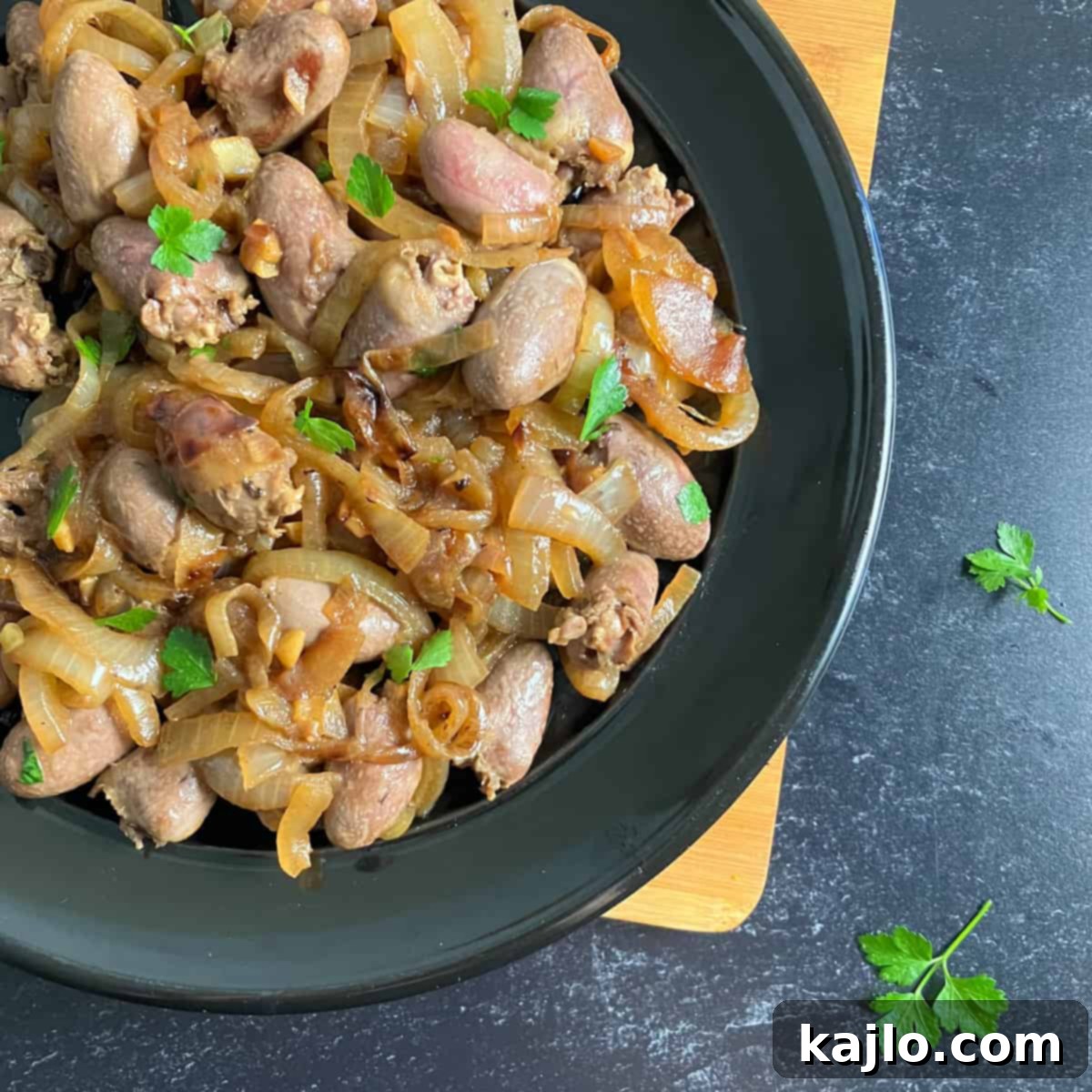
The Distinct Flavor and Texture of Chicken Hearts
Many home cooks might wonder, what do chicken hearts taste like? If you’re hesitant about organ meats, you’re in for a pleasant surprise. Chicken hearts are essentially muscle meat, and their flavor profile is remarkably similar to that of dark meat chicken, such as chicken thighs, rather than the more intense, “gamey” taste often associated with chicken liver or kidney. They possess a mild, slightly earthy flavor with a subtle richness that isn’t overpowering.
When prepared correctly, sauteed chicken hearts boast a firm yet tender bite. Overcooked hearts can become rubbery, but with precise timing, they achieve a delightful succulence. This makes them an approachable entry point for anyone curious about incorporating organ meats into their diet. Their agreeable taste and texture are a major reason for their growing popularity in diverse cuisines worldwide.
A Versatile Ingredient for Culinary Exploration
While chicken hearts aren’t a staple in every American kitchen, they are celebrated in many cultures, often featured on skewers at Brazilian steakhouses or found in various Asian and Latin American dishes. Their versatility extends far beyond a simple pan-fry. Imagine them simmered in a rich curry, skewered and grilled for a smoky flavor, or finely chopped and incorporated into a savory stuffing. This recipe focuses on a straightforward sauté, allowing the natural deliciousness of the hearts to shine. However, feel free to experiment with different fats like ghee or lard, and a variety of herbs and spices. Consider adding complementary ingredients such as sautéed mushrooms, leeks, bell peppers, or even a splash of red wine for a more complex and satisfying dish.

Where to Find Fresh Chicken Hearts for Your Recipe
Sourcing raw chicken hearts might require a little more effort than buying chicken breasts, but it’s well worth it. If you’re wondering, where to buy chicken hearts near me? There are several reliable avenues to explore. Your best local bets include East Asian and Hispanic markets, where organ meats are a common and valued part of the culinary tradition. These stores often carry pre-packaged chicken hearts, sometimes alongside gizzards.
Beyond specialty markets, don’t hesitate to check with the meat department at larger grocery stores like Whole Foods. Many will gladly place a special order for you, ensuring you get fresh, high-quality hearts. Local farms and farmer’s markets are another fantastic resource, often providing pasture-raised options that are both flavorful and ethically sourced. For those who prefer the convenience of online shopping, specialty meat retailers like US Wellness Meats occasionally offer pasture-raised chicken hearts, which can be delivered right to your door. Investing a little time in finding a good source ensures you start with the best possible ingredients for your dish.
Understanding Chicken Hearts Price and Quality
The typical chicken hearts price can vary significantly depending on where you purchase them. At local grocery stores or specialty markets, you might find them for around $3-$5 per pound, making them a very economical protein source. However, if you opt for pasture-raised or organic chicken hearts from online retailers or smaller, specialized butchers, expect to pay a premium. For instance, online prices can range from $15-$20 per pound. While the higher price reflects quality and sourcing, even at these rates, the nutritional density and unique culinary experience often justify the cost for many home cooks.
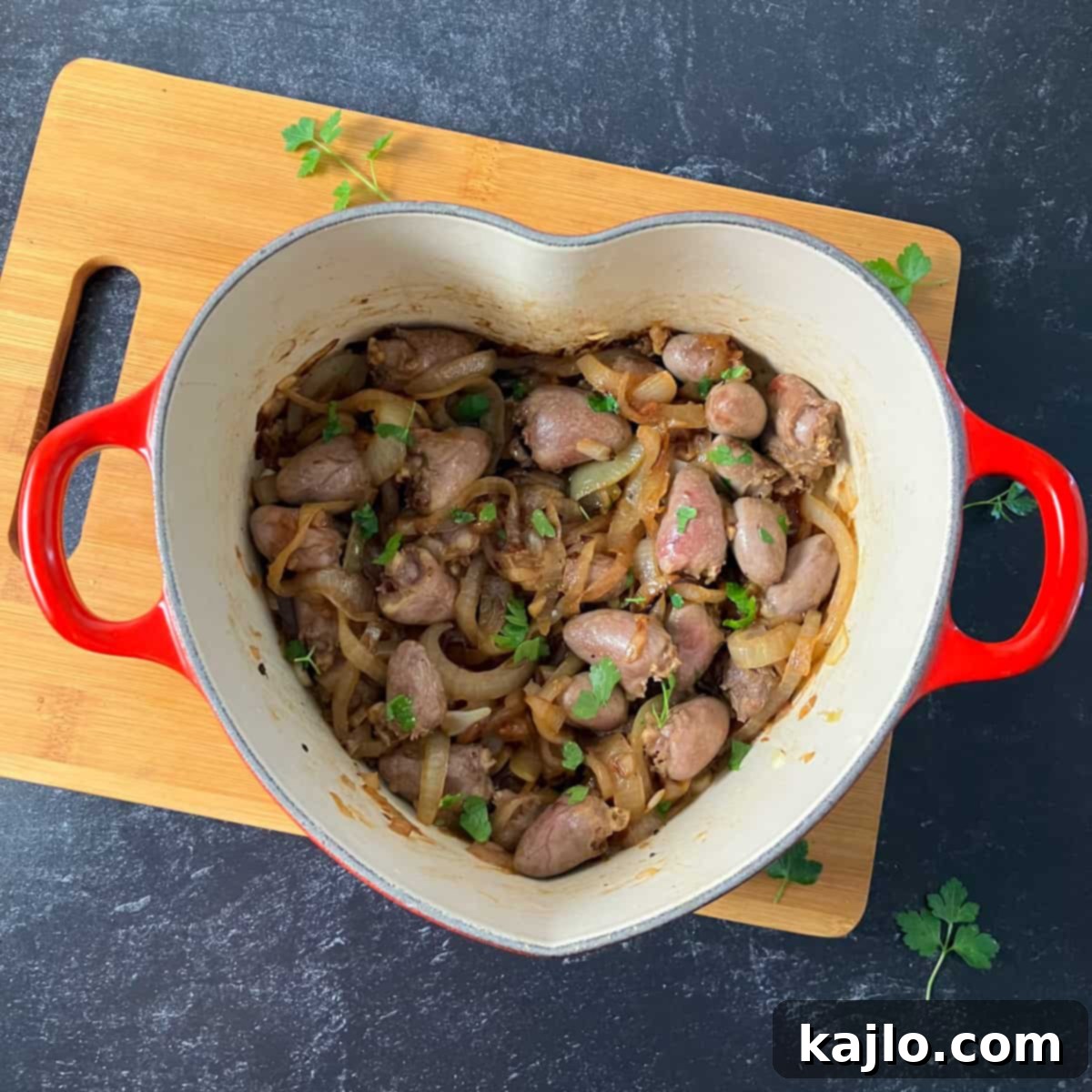
The Remarkable Nutritional Benefits of Chicken Hearts
Why eat chicken hearts? The list of benefits of chicken hearts is extensive, making them a true powerhouse of nutrition. Often classified as a “nutrient-dense” food, chicken hearts pack a significant amount of essential vitamins and minerals into a relatively small serving. Here’s a breakdown of the impressive nutrition profile for a 4-ounce (113-gram) serving, based on data from Cronometer:
- Calories: 174 – A moderate calorie count for a satisfying serving.
- Carbohydrates: 1 gram – Extremely low-carb, making them suitable for keto and low-carb diets.
- Fiber: 0 grams – As an animal product, they contain no fiber.
- Fat: 11 grams – Provides a good source of energy and aids in nutrient absorption.
- Saturated Fat: 3 grams – A modest amount, especially when balanced in a healthy diet.
- Cholesterol: 154 mg – While high in dietary cholesterol, research suggests dietary cholesterol has less impact on blood cholesterol levels than saturated fat.
- Protein: 18 grams – An excellent source of high-quality, complete protein essential for muscle repair and growth.
- Thiamin (Vitamin B1): 12% DV – Important for energy metabolism and nerve function.
- Riboflavin (Vitamin B2): 49% DV – Crucial for energy production and cellular growth.
- Niacin (Vitamin B3): 28% DV – Plays a key role in DNA repair and energy conversion.
- Pantothenic Acid (Vitamin B5): 29% DV – Essential for hormone production and fatty acid metabolism.
- Vitamin B6: 20% DV – Vital for brain development and immune function.
- Vitamin B12: 138% DV – An outstanding source, crucial for nerve function, red blood cell formation, and DNA synthesis.
- Folate (Vitamin B9): 20% DV – Important for cell growth and function.
- Vitamin A: 1% DV – A small amount, but still contributes to overall nutrient intake.
- Vitamin C: 6% DV – Provides a minor boost of this antioxidant.
- Calcium: 1% DV – Contributes to bone health.
- Iron: 38% DV – An excellent source of highly bioavailable heme iron, vital for preventing anemia and supporting oxygen transport.
- Magnesium: 4% DV – Involved in over 300 biochemical reactions in the body.
- Phosphorus: 20% DV – Essential for bone health and energy storage.
- Potassium: 6% DV – Important for fluid balance and blood pressure.
- Selenium: 7% DV – A powerful antioxidant that supports thyroid function.
- Zinc: 50% DV – An exceptional source, critical for immune function, wound healing, and DNA synthesis.
Beyond these, chicken hearts are also rich in taurine, an amino acid beneficial for cardiovascular health and overall cellular function. For those adhering to specific dietary patterns, chicken hearts are naturally keto-friendly, low-carb, Paleo, and gluten-free, making them an excellent choice for a wide range of healthy lifestyles.
Simple Ingredients for Pan Fried Chicken Hearts
Crafting this delicious chicken hearts recipe requires just a few basic ingredients, most of which you likely already have in your pantry. The simplicity of this dish allows the natural flavors of the chicken hearts to truly shine:
- Fresh Chicken Hearts: The star of our dish. If using frozen chicken hearts, ensure they are thoroughly thawed before cooking for even results.
- Olive Oil: A healthy and flavorful cooking fat. You can substitute with canola oil, avocado oil, ghee, or even lard for a different flavor profile.
- Garlic Cloves: Minced garlic adds a fragrant and savory depth to the dish.
- Thinly Sliced Onions: As they caramelize, onions provide a sweet and aromatic contrast to the richness of the hearts.
- Salt and Black Pepper: Essential seasonings to enhance all the flavors. Adjust to your personal taste.
The precise quantities for each ingredient are detailed in the recipe card located at the bottom of this article. For frozen chicken hearts, the best method for thawing is to transfer them to the refrigerator 24-48 hours before you plan to cook, allowing them to defrost slowly and safely.
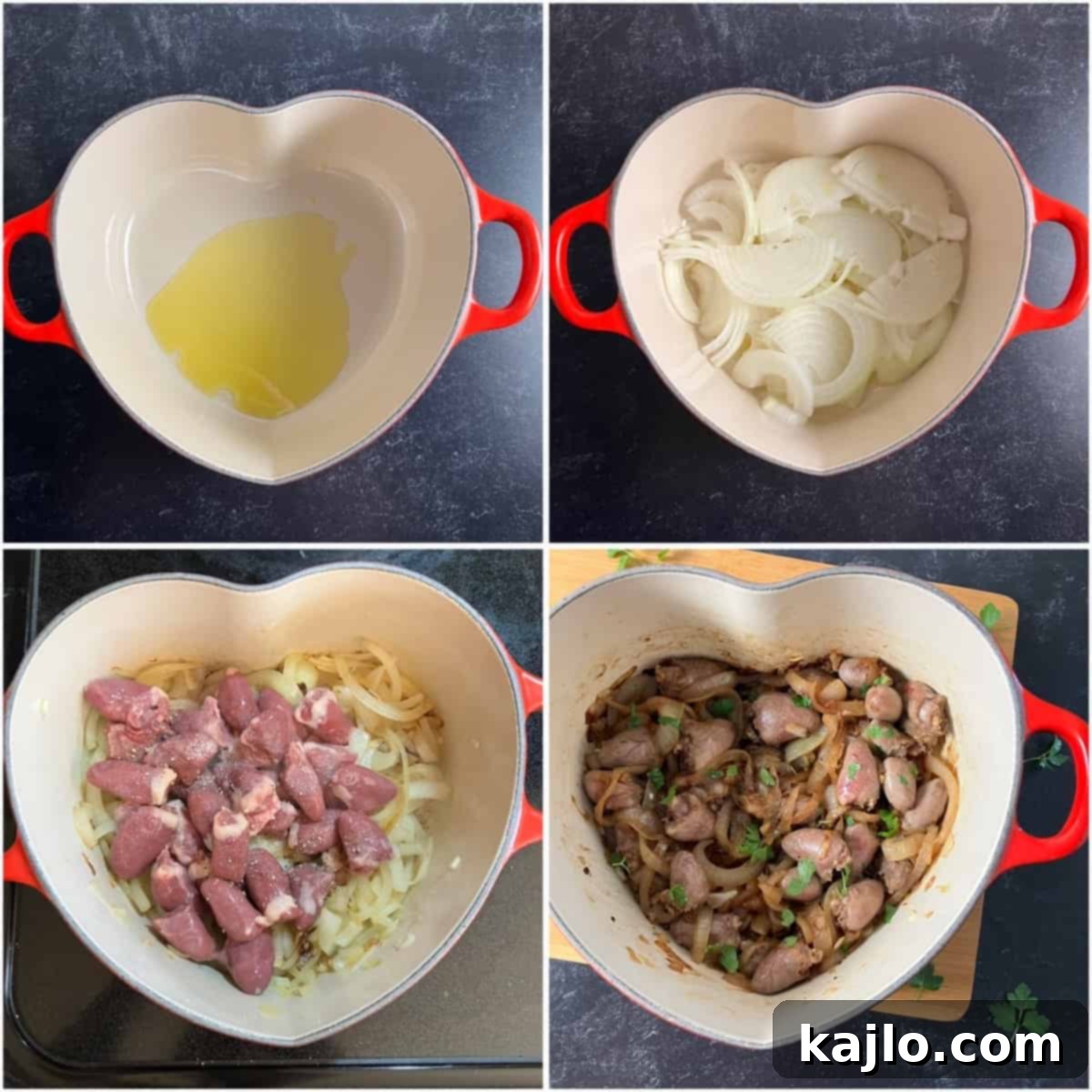
Preparation and Cooking Instructions for Chicken Hearts
Do Chicken Hearts Need to Be Cleaned?
A common question is, do chicken hearts need to be cleaned? According to the USDA, it is generally not recommended to wash raw poultry before cooking. Rinsing raw meats can inadvertently spread bacteria to other surfaces in your kitchen, increasing the risk of cross-contamination. Modern poultry processing ensures that chicken hearts are clean and ready for cooking straight from the package. Any visible small pieces of connective tissue or fat can be trimmed if desired, but it’s often unnecessary.
Step-by-Step Guide: How to Cook Chicken Hearts
This method focuses on achieving tender, flavorful sauteed chicken hearts that are perfect every time. Follow these simple steps:
- Begin by preparing your aromatics. Peel your onion and slice it thinly into delicate half-moons. Mince the garlic cloves finely to maximize their flavor release.
- Heat your chosen cooking oil in a small enameled cast iron Dutch oven or a heavy-bottomed skillet over medium-high heat. Once hot, add the sliced onions and minced garlic. Sauté them for 5-10 minutes, stirring occasionally, until the onions are softened and translucent, and the garlic is fragrant. Be careful not to burn the garlic.
- Reduce the stovetop heat to medium. Introduce the raw chicken hearts to the pan, along with a generous pinch of salt and black pepper. Continue to cook for another 5-8 minutes, stirring frequently to ensure even cooking and browning. The hearts should develop a lovely browned crust on the outside while remaining tender within.
- To enhance the visual appeal and add a touch of freshness, consider garnishing the finished dish with a sprinkle of fresh chopped parsley or chives. This step is entirely optional but adds a vibrant touch.
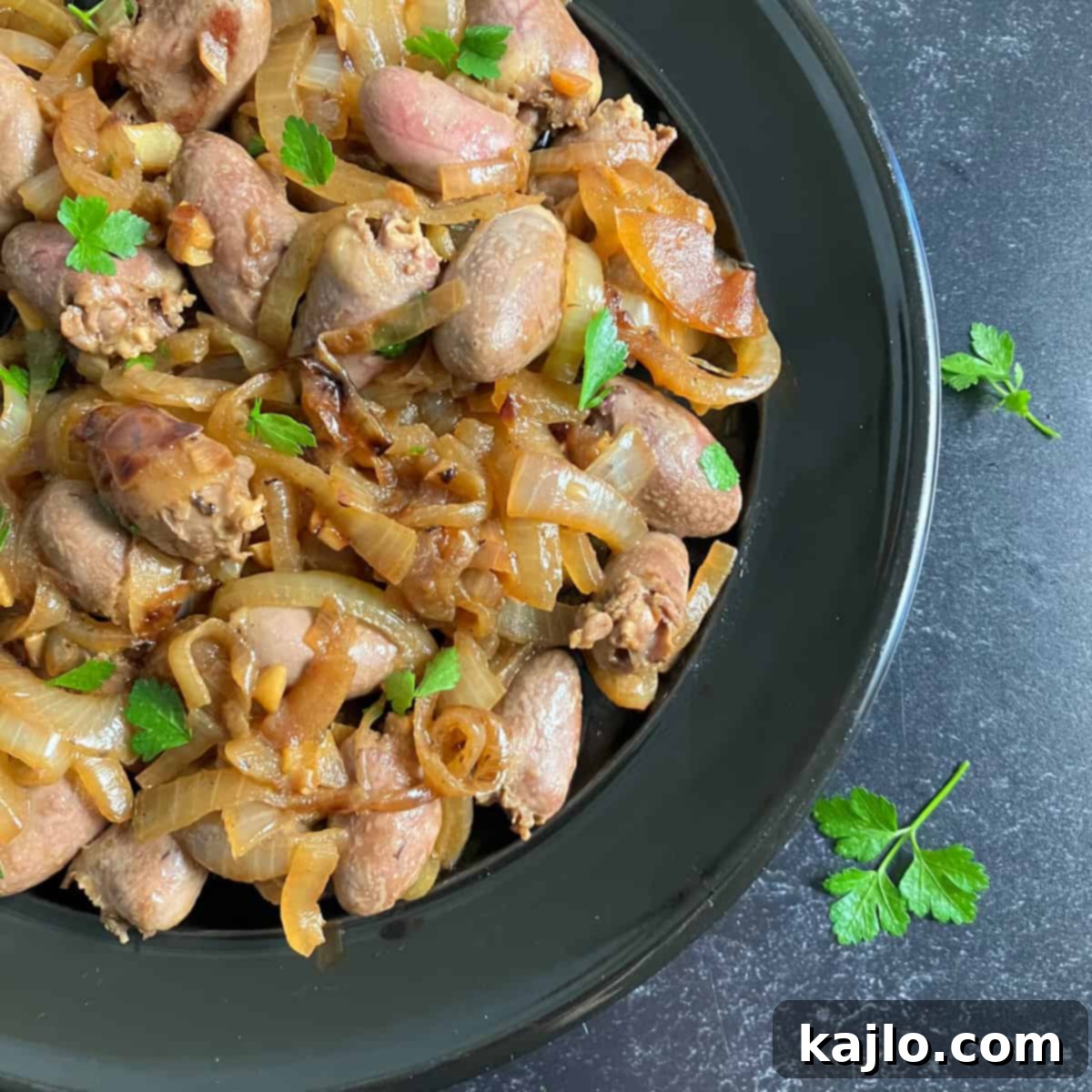
When are Chicken Hearts Done?
Knowing when are chicken hearts done? is crucial for both food safety and optimal texture. Like all poultry, chicken hearts should reach a minimum safe internal temperature of 165°F (74°C). The most reliable way to confirm doneness is by using a meat thermometer. Insert the thermometer into the thickest part of a heart. It’s equally important not to overcook them, as this can quickly lead to a tough, rubbery texture. Once they hit 165°F, remove them from the heat promptly.
Alternative Cooking Methods for Chicken Hearts
While pan-frying yields fantastic results, chicken hearts are versatile enough for various cooking methods:
- How long to boil chicken hearts? Boiling is an excellent method for tenderizing hearts, especially if you plan to use them in stews, curries, or as part of a larger dish. Boil chicken hearts in water or broth for approximately 30 minutes, or even longer if you desire an exceptionally tender result. Always ensure they reach 165°F (74°C) internally.
- How to make fried chicken hearts? For a crispy, indulgent treat, deep-fried chicken hearts are fantastic. Batter the chicken hearts lightly and heat fryer oil to 350°F (177°C). Deep fry for 3-4 minutes until golden brown and a safe internal temperature of 165°F (74°C) is reached.
- How to make air fryer chicken hearts? For a healthier crispy option, preheat your air fryer to 400°F (200°C). Air fry chicken hearts for 15-20 minutes, shaking or stirring every 5 minutes, until they are golden and reach 165°F (74°C).
- How to make oven baked chicken hearts? Roasted chicken hearts are simple to prepare. Toss them with oil and seasonings, then bake in an oven preheated to 400°F (200°C) for 20-25 minutes. Again, verify doneness with a meat thermometer.
- How to make a chicken hearts Instant Pot recipe? Pressure cooking offers a quick way to achieve tender hearts. Cook chicken hearts on high pressure in an Instant Pot for 20 minutes with some broth, then allow for a 10-minute natural pressure release. This method is particularly useful if you’re cooking hearts alongside gizzards, which benefit from longer cooking times.
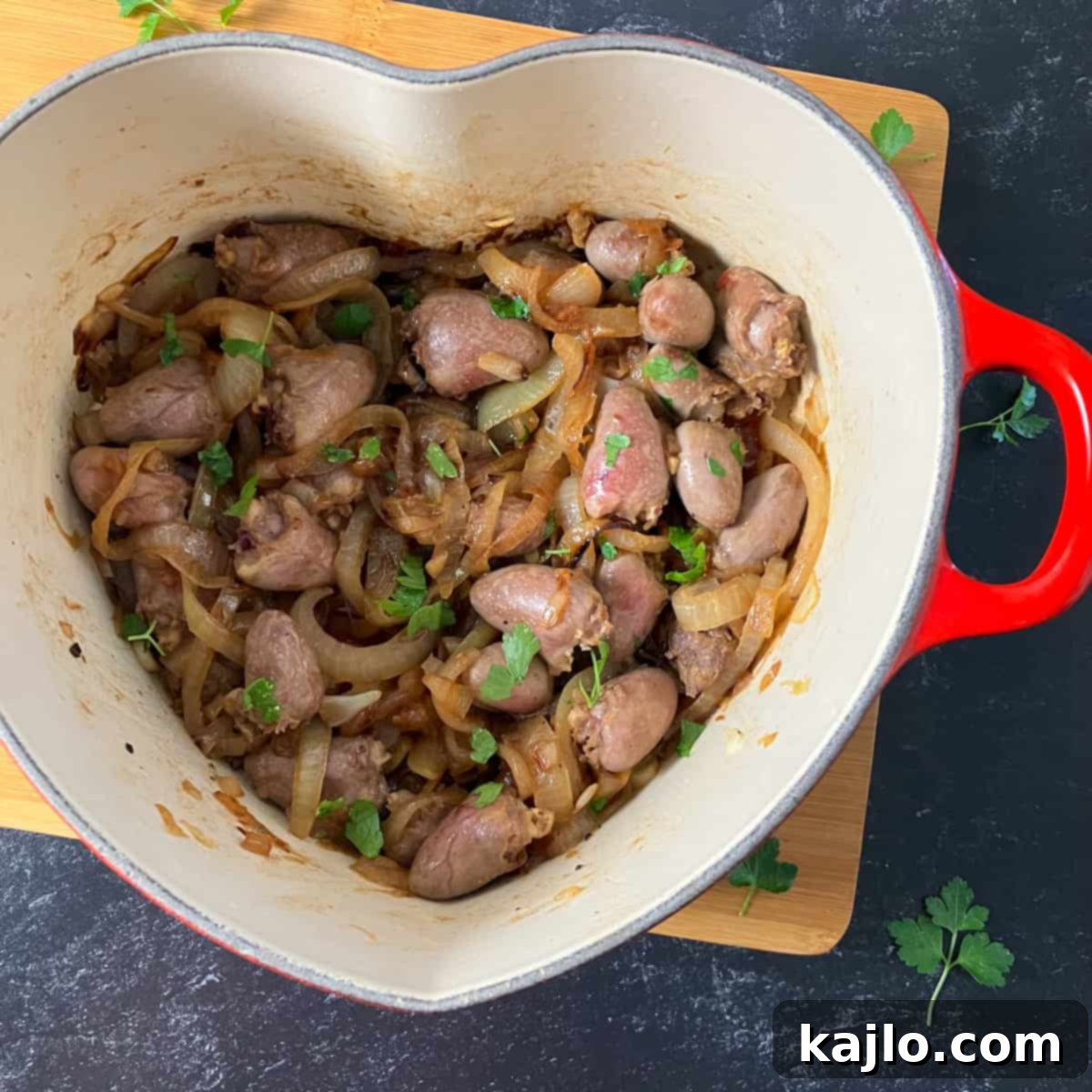
Storage and Serving Suggestions for Chicken Hearts
Chicken Hearts Storage Guidelines
Proper storage ensures you can enjoy your cooked chicken hearts safely for longer. Once cooled, cooked chicken hearts can be stored in an airtight container in the refrigerator for 3-4 days. Both raw and cooked chicken hearts can also be frozen for extended storage. For best results and to prevent freezer burn, store them in a vacuum-sealed freezer bag or a heavy-duty freezer container. Thaw frozen hearts in the refrigerator before reheating.
How to Serve Chicken Hearts
Chicken hearts are incredibly versatile and can be enjoyed in many ways. They make a highly nutritious snack all on their own, especially when seasoned well. As a main course, they pair wonderfully with a variety of side dishes that complement their rich flavor and tender texture. Here are some ideas for creating a complete and satisfying meal:
- Cauliflower Rice or White Rice: A classic pairing that allows the hearts to be the star. Cauliflower rice is perfect for low-carb diets.
- Mashed Potatoes: Creamy mashed potatoes provide a comforting contrast and soak up any delicious pan juices.
- Air Fryer Frozen Green Beans: A quick and easy vegetable side that adds freshness and a hint of crispness.
- Vegan Spinach Salad: A light, vibrant salad can balance the richness of the chicken hearts.
- Crusty Bread: Perfect for dipping into the flavorful pan sauce.
- Polenta or Grits: A creamy base that works well with the savory hearts.
- Roasted Root Vegetables: Carrots, parsnips, or sweet potatoes roasted alongside can add sweetness and texture.
- Lemon Wedges: A squeeze of fresh lemon juice brightens the flavors immensely.
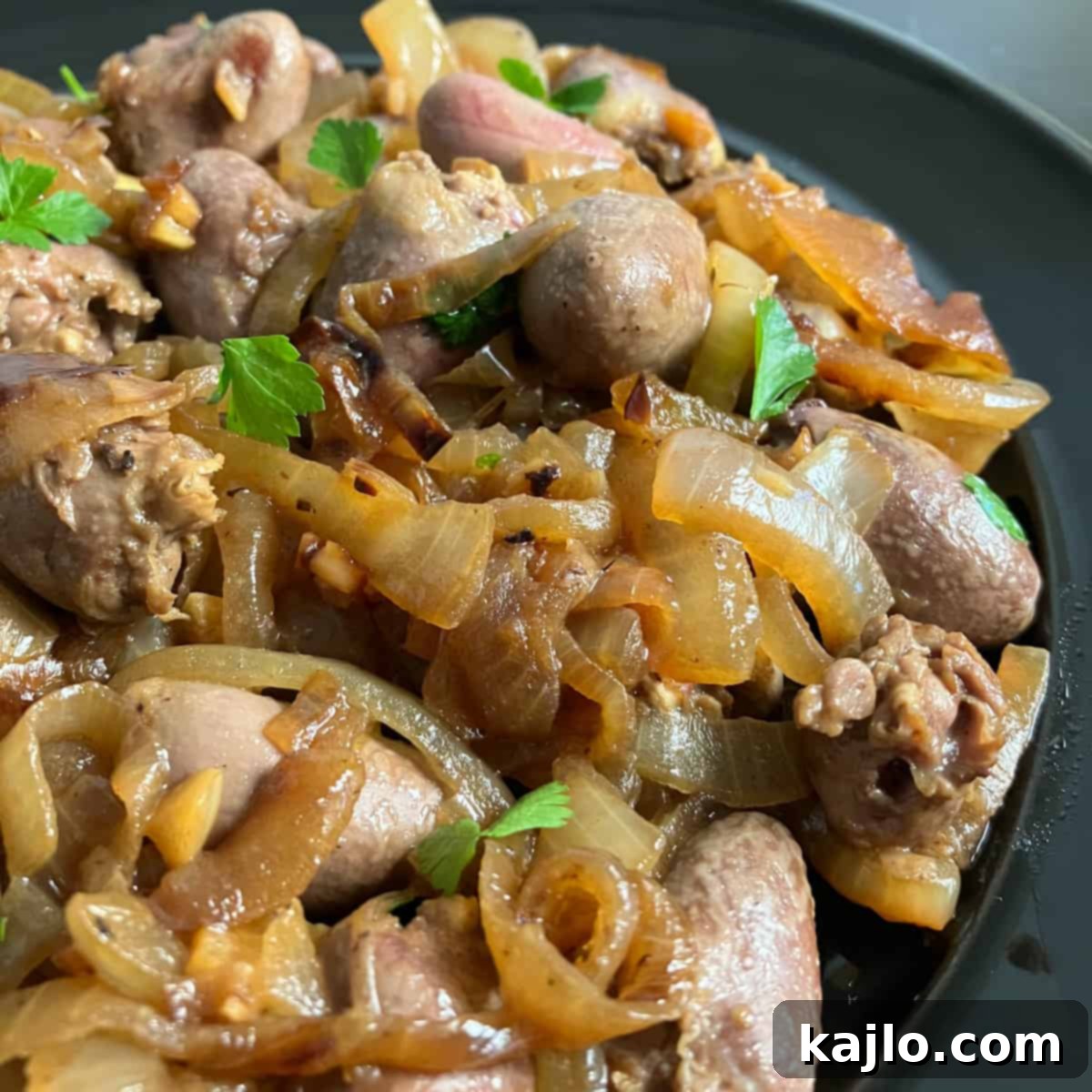
Chicken Hearts Calories per Serving
When considering nutritional intake, it’s helpful to differentiate between raw and prepared chicken hearts. Raw chicken hearts typically contain around 174 calories per 4 ounces (113 grams). However, this specific chicken heart recipe, which includes oil and onions, yields approximately 280 calories, 12.4 grams of net carbohydrates, and 18.5 grams of protein per serving, making it a well-rounded and energy-boosting meal.
FAQs About Cooking and Enjoying Chicken Hearts
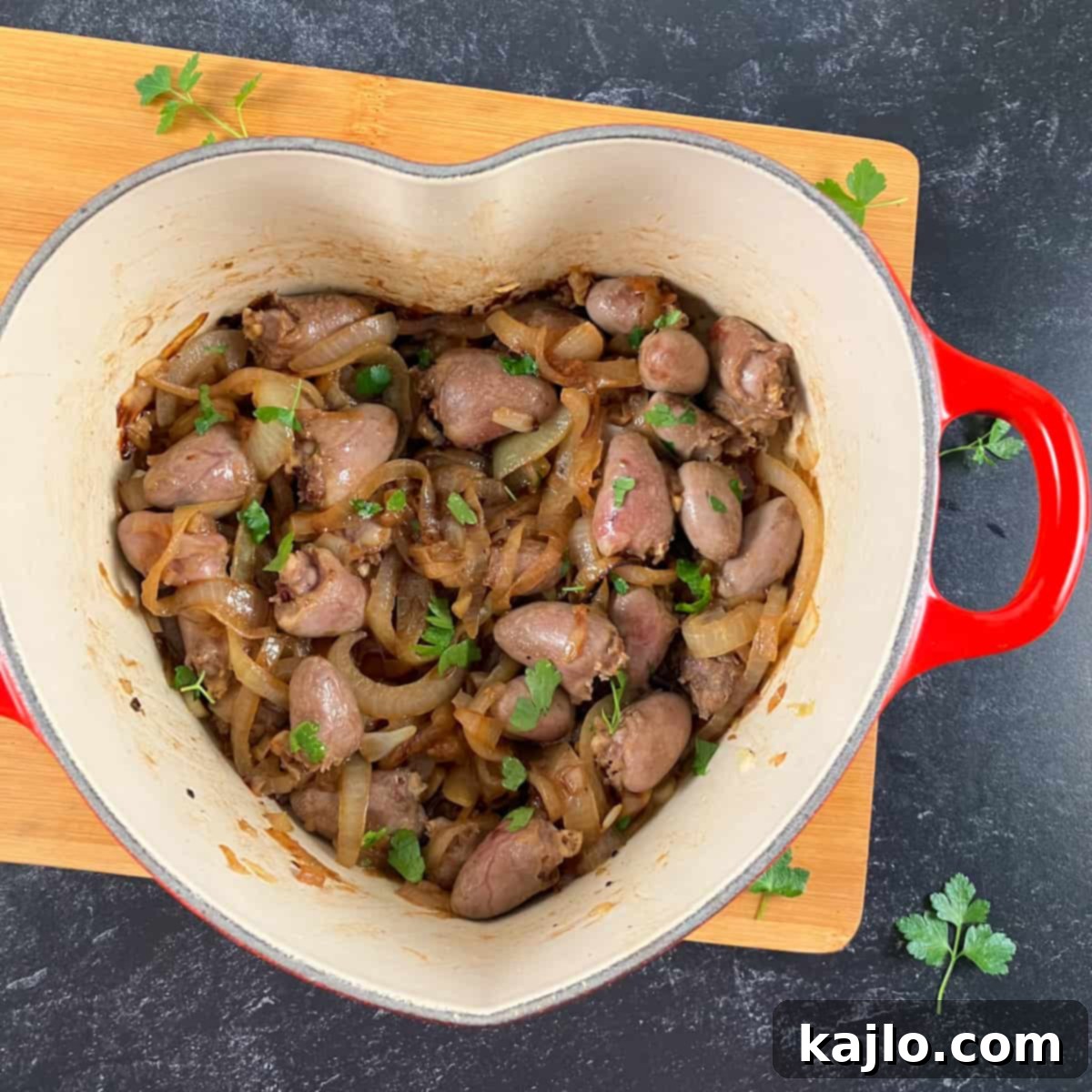
Are chicken hearts good for dogs?
Yes, cooked chicken hearts can be a healthy and delightful treat for dogs. They are packed with beneficial nutrients. However, they should be offered in moderation as an occasional treat and not form the entirety of your dog’s diet. Always cook the chicken hearts thoroughly and allow them to cool completely before serving them to your canine companion.
Creative Recipes with Chicken Hearts
If you’re looking for even more innovative ways to use chicken hearts beyond this pan-fried recipe, their robust flavor makes them a versatile addition to many dishes:
- Chicken Hearts Curry: Simmer them in a rich, aromatic curry sauce for a comforting and flavorful meal, perfect served with rice.
- Ground Meat Substitute: Finely chop chicken hearts and incorporate them into recipes that call for ground beef, turkey, or pork. This adds a unique depth of flavor and a nutritional boost. Try this in:
- Meatloaf in Air Fryer: Mix some finely chopped hearts into your meatloaf mixture for added richness.
- Air Fryer Spaghetti Bolognese Sauce: Elevate your bolognese by adding finely minced chicken hearts to the ground meat.
- Stuffed Bell Peppers (Air Fryer): Include chicken hearts in your savory stuffing for bell peppers.
- Goulash or Stews: Their firm texture holds up well to slow cooking, absorbing the flavors of hearty stews and goulash.
- Tacos or Stir-Fries: Quickly sautéed chicken hearts can be a fantastic protein for tacos, fajitas, or an Asian-inspired stir-fry.
Watch How to Make It!
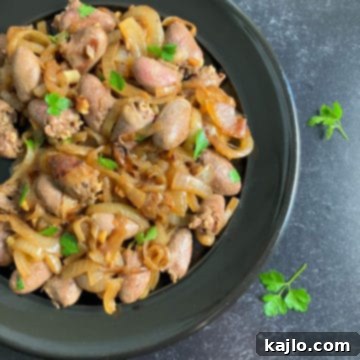
Chicken Hearts (Chicken Heart Recipe)
Summer Yule
Print Recipe
Pin Recipe
Ingredients
- 8 ounces chicken hearts 227 grams
- 1 tablespoon olive oil
- 8 ounces onion 227 grams (about ½-1 onion)
- 2 cloves garlic
- salt and pepper, to taste
Instructions
- Cut the peeled onion in half, and then cut it into thin half-moons. Mince the garlic cloves.
- Put the onions, garlic, and oil in a small ceramic-coated cast iron Dutch oven and cook for 5-10 minutes on the stove over medium-high heat. Stir occasionally.
- Turn the heat on the stovetop down to medium. Add the chicken hearts, salt and pepper. Cook for 5-8 minutes more, stirring frequently.
- Chicken hearts should reach a minimum safe internal temp of 165°F (74°C). I recommend using a meat thermometer to check for doneness. Add additional cooking time if needed, and enjoy!
Equipment
- Knife
- Small Dutch Oven
- Kitchen Thermometer
Notes
💭 Expert Tips from Dietitian Summer Yule
This is a level 2 recipe (transition or weight maintenance). Are chicken hearts good for you? Do chicken hearts have iron? Packed with highly bioavailable iron and zinc, and rich in B-complex vitamins, chicken hearts are definitely nutritious. Their nutrient density makes them an excellent choice for supporting overall health and vitality.
I often see chicken hearts described as “lean protein,” but that’s not entirely accurate. While they are a fantastic source of protein, chicken hearts contain a notably higher fat content compared to leaner options like skinless chicken breast. This higher fat content doesn’t make them unhealthy; instead, it means they offer a richer flavor and contribute more calories by weight. This makes them a satisfying and energy-dense entrée option.
I observe two primary factors that might deter individuals from trying chicken hearts. The first is their limited availability in mainstream US grocery stores. As discussed earlier, you might need to actively seek them out in specialty markets or place special orders, especially if you’re looking for competitive pricing.
The second barrier is a prevalent cultural squeamishness surrounding the consumption of organ meats. If this resonates with you, I encourage you to set aside any reservations and give them a try. Many people are genuinely surprised by how much they enjoy the mild flavor and tender texture of chicken hearts.
I view meals featuring organ meats as a special delicacy to be savored. Reflecting on the fact that each chicken provides only one small heart serves as a powerful reminder to appreciate and minimize waste from the animals that nourish us and our families. Incorporating organ meats into your diet is not only good for your health but also a step towards more sustainable and mindful eating practices.
Nutrition information is for one serving.
Nutrition Info Disclaimer
All recipes on this website may or may not be appropriate for you, depending on your medical needs and personal preferences. Consult with a registered dietitian or your physician if you need help determining the dietary pattern that may be best for you.
The nutrition information is an estimate provided as a courtesy. It will differ depending on the specific brands and ingredients that you use. Calorie information on food labels may be inaccurate, so please don’t sweat the numbers too much.
“To taste” means to your preferences, which may have to be visual to follow food safety rules. Please don’t eat undercooked food x
Nutrition
Join our community! Subscribe for all of the latest and greatest recipes, and follow me on Facebook, Pinterest, Instagram, and YouTube!
